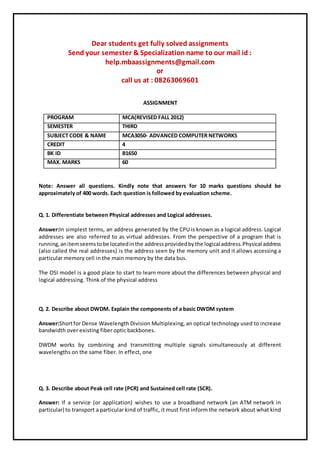
Mca3020 advanced database management system
- 1. Dear students get fully solved assignments Send your semester & Specialization name to our mail id : help.mbaassignments@gmail.com or call us at : 08263069601 ASSIGNMENT PROGRAM MCA(REVISED FALL 2012) SEMESTER THIRD SUBJECT CODE & NAME MCA3050- ADVANCED COMPUTER NETWORKS CREDIT 4 BK ID B1650 MAX. MARKS 60 Note: Answer all questions. Kindly note that answers for 10 marks questions should be approximately of 400 words. Each question is followed by evaluation scheme. Q. 1. Differentiate between Physical addresses and Logical addresses. Answer:In simplest terms, an address generated by the CPU is known as a logical address. Logical addresses are also referred to as virtual addresses. From the perspective of a program that is running,anitemseemstobe locatedinthe addressprovidedbythe logical address.Physical address (also called the real addresses) is the address seen by the memory unit and it allows accessing a particular memory cell in the main memory by the data bus. The OSI model is a good place to start to learn more about the differences between physical and logical addressing. Think of the physical address Q. 2. Describe about DWDM. Explain the components of a basic DWDM system Answer:Shortfor Dense Wavelength Division Multiplexing, an optical technology used to increase bandwidth over existing fiber optic backbones. DWDM works by combining and transmitting multiple signals simultaneously at different wavelengths on the same fiber. In effect, one Q. 3. Describe about Peak cell rate (PCR) and Sustained cell rate (SCR). Answer: If a service (or application) wishes to use a broadband network (an ATM network in particular) to transport a particular kind of traffic, it must first inform the network about what kind
- 2. of traffic is to be transported, and the performance requirements of that traffic. The application presents this information to the network in the form a traffic contract. An example of trafficthatrequiresthistype of service categoryare variable rate, compressed video streams.Sourcesthatuse rt-VBR connectionsare expectedtotransmitata rate that varieswithtime (forexample,trafficthatcan be consideredbursty).Real-time VBRconnectionscanbe characterized by a PeakCell Rate (PCR), Sustained Cell Rate (SCR), and Maximum Burst Size (MBS). Cells delayed beyond the value specified by the maximum CTD Q. 4. Describe the following: a) Open Shortest Path First (OSPF) protocol Answer:OpenShortestPath First (OSPF) is a routing protocol for Internet Protocol (IP) networks. It uses a link state routing algorithm and falls into the group of interior routing protocols, operating withinasingle autonomoussystem (AS). It is defined as OSPF Version 2 in RFC 2328 (1998) for IPv4. The updates for IPv6 are specified as OSPF Version 3 in RFC 5340 (2008). OSPF is perhaps the most widely used interior b) Broader Gateway Routing Protocol (BGP) Answer:Border Gateway Protocol (BGP) is a standardized exterior gateway protocol designed to exchange routingandreachabilityinformationbetween autonomous systems (AS) on the Internet. The protocol is oftenclassifiedasapath vectorprotocol but issometimesalsoclassed as a distance- vector routing protocol. The Border Gateway Protocol makes routing decisions based on paths, networkpolicies,orrule-setsconfiguredby a network administrator and is involved in making core routing decisions. BGP may be used for routing within an AS. In this Q. 5. Write short notes on: a) Cryptography: Cryptography prior to the modern age was effectively synonymous with encryption, the conversion of information from a readable state to apparent nonsense. The originatorof an encrypted message shared the decoding technique needed to recover the original information only with intended recipients, thereby precluding unwanted persons from doing the same.Since WorldWar I and the adventof the computer, the methods used to carry out cryptology have become increasingly complex and its application more widespread. b) Encryption:In cryptography, encryption is the process of encoding messages or information in such a way that only authorized parties can read it. Encryption does not of itself prevent interception, but denies the message
- 3. c) Decryption:Decryptionisthe reverse process to Encryption. Frequently, the same Cipher is used for both Encryption and Decryption. While Encryption creates a Ciphertext from a Plaintext, Decryption creates a Plaintext from a Ciphertext. The process of decoding data that has been encrypted into a secret format. Decryption requires a secret key or password. Decryption is the process of converting ciphertext back to plaintext. To encrypt more than a small amount of data, symmetric encryption is used. A symmetric d) Cryptanalysis:Cryptanalysisreferstothe studyof ciphers,ciphertext,orcryptosystems(thatis,to secret code systems) with a view to finding weaknesses in them that will permit retrieval of the plaintextfromthe ciphertext,withoutnecessarilyknowingthe keyorthe algorithm.Thisisknown as breaking the cipher, ciphertext, or cryptosystem. Cryptanalysisisthe study of analyzing information systems in order to study the hidden aspects of the systems. Cryptanalysis is used to breach e) Cryptology:Cryptology is the mathematics, such as number theory, and the application of formulas and algorithms, that underpin cryptography and cryptanalysis. Since the cryptanalysis concepts are highly specialized and Q. 6. Differentiate between Single server queue and Multi-server queue Answer:Queueingtheoryisthe mathematicalstudy of waitinglines,orqueues. Inqueueingtheory a model is constructed so that queue lengths and waiting time can be predicted.Queueing theory is generally considered a branch of operations research because the results are often used when makingbusinessdecisionsaboutthe resourcesneededtoprovideaservice. Queueing theory has its origins in research by Agner Krarup Erlang when he created models to describe the Copenhagen telephone exchange. The ideas have since Dear students get fully solved assignments Send your semester & Specialization name to our mail id : help.mbaassignments@gmail.com or call us at : 08263069601
